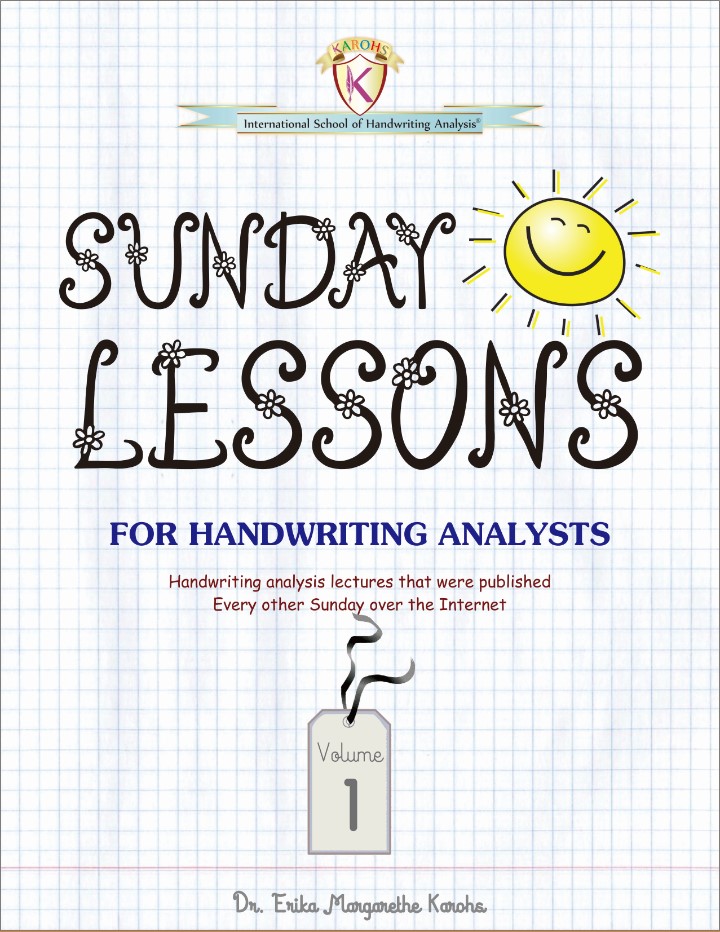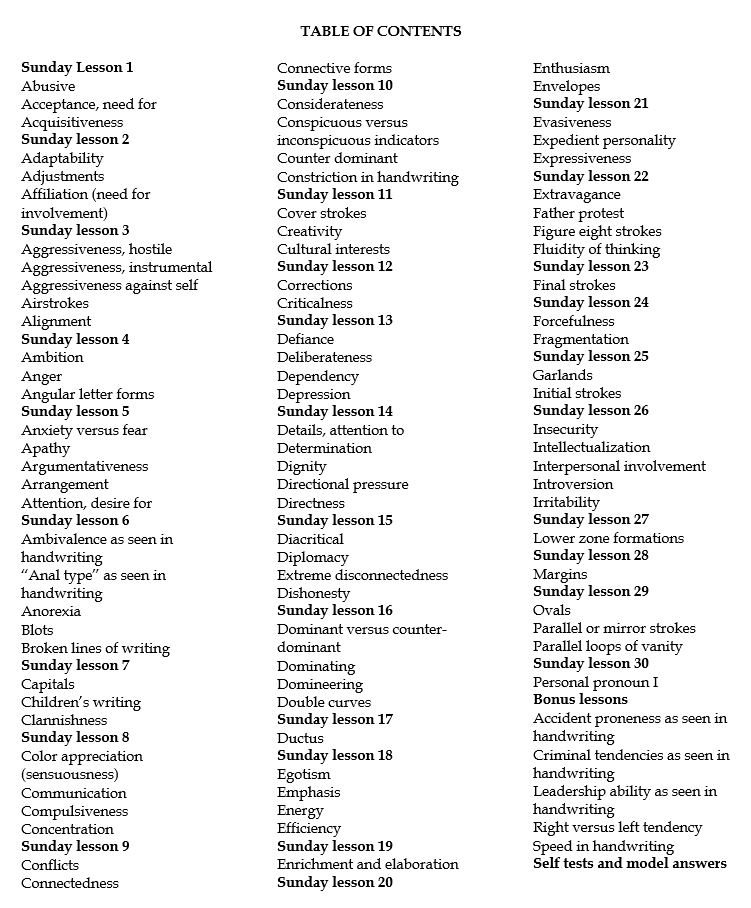FREE ARTICLES OF HANDWRITING ANALYSIS For YOU 🙂
17 FREE ARTICLES
Register and Enjoy our FREE Graphology Articles by Dr. Erika M. Karohs, and also receive updates about events and discounts. All about Handwriting Analysis.
After you submit, you will receive these monthly articles:

Rolled Strokes
According to Crépieux-Jamin, rolled strokes were among the earliest signs recognized by people fascinated with handwriting analysis.

Air Strokes
Airstrokes are connecting lines from one zone to another in which the writing instrument has been slightly lifted off the paper
Alignments
Letters, words and lines are symbolic for various time spans in the writer’s life. Their alignment (horizontal direction) reveals the writer’s inner feelings and outward behavior.
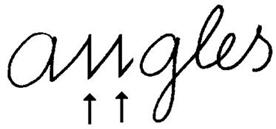
Thinking Pattern
In graphology, thinking has to do with HOW the person thinks, now what he thinks about or how much quality there is to his thinking.“HOW” breaks down into four categories which will describe in this articles

Accident Proneness
According to Pfanne, insurance companies have long ago discovered that one particular group of people seems to suffer a large percentage of all accidents, whereas other individuals remain relatively accident free. Unfortunately, industry often keeps such persons in hazardous work situations and will relocate them only after a series of additional mishaps.
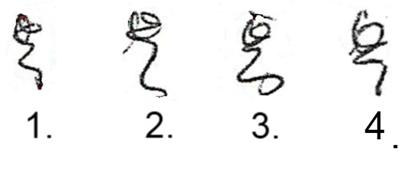
Discussion and Quiz
Nervousness According to Merten, these writers are “nervous and agitated without reason. They are restless and it irritates them to be inactive. Often, their movements are random, without purpose and direction. They may be finger-drumming and foot-tapping. They pace, just for the sake of moving. Their mind is not easily directed toward one activity for a longer period of time.”

Directional Pressure
Directional pressure is not the type of pressure normally discussed in graphology. “It is an invisible pressure coming out of one of the four directions of the writing field, a pressure always of a negative nature and always having the effect of changing a straight downstroke into a curved one.”

Double Curves
The writer has the ability to create without precedent. His mind functions inventively, reaching conclusions that are not the norm. He has an original approach to things and puts his personal stamp on whatever he does.

Non-Manager Discussions
“The word manager,” says Fervers (German graphologist), “holds a kind of magic. It symbolizes power, wealth, status and influence. Not surprisingly, many people seem to believe that, ideally, they should become managers, regardless of their qualifications – or lack of it.”
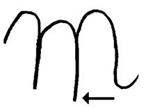
The Letter "M"
Max Pulver, a renowned Swiss graphologist, identifies the first prong with the I, (the writer himself); the second prong with the you (family members, close friends) and the third point with it (other people in the writer’s environment).

Soldered (sautered) Writing
Sautered or soldered writing is an important graphological phenomenon about which relatively little is known. This is not due to the fact that it occurs only seldom, but rather that it is fairly difficult to recognize without magnification
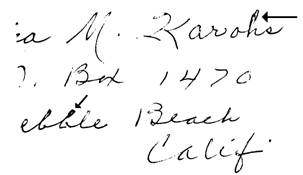
2 Most Frequent Questions
(1) What are the uses of handwriting analysis?
(2) How is Handwriting analysis going to help me personally?
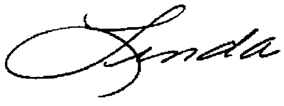
Emphasis
Initial emphasis means exaggeration of the first stroke, letter or word either in size, height, pressure, or form.
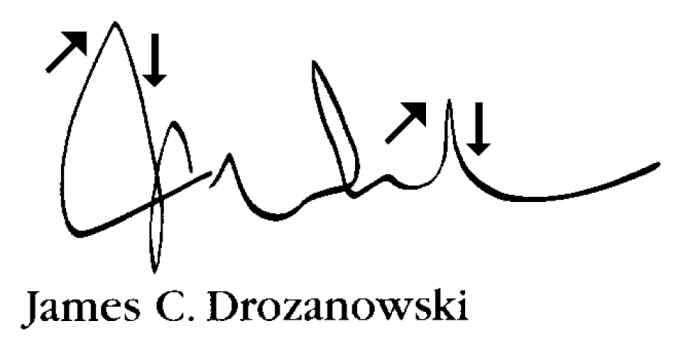
Demeaning Others
The following article was written by Július Zemaník, one of the most outstanding students and graduates of the KAROHS International School of Handwriting Analysis®.
Register Here
Subscribe Now and Enjoy All Articles we send to your email 🙂

New Paper 2017: “Demeaning Others“
The following article was written by Július Zemaník, one of the most outstanding students and graduates of the KAROHS International School of Handwriting Analysis®.
It is a description of a graphology trait discovered by Magdalena Ivanovic, a renowned German graphologist who seems to have been way ahead of her time in her graphological research and discoveries. Unfortunately, she received little recognition during her lifetime. Ivanovic herself lamented that her ideas were poorly received and her (books) were never mentioned in any of the graphological publications of her time. She expressed the wish that her work would at least inspire future graphologists to undertake research in areas she suggested.
It seems that this time has come. Contemporary graphologists are finally recognizing the innovative work Ivanovic did and the cutting-edge theories she developed. Dr. Erika Karohs, in her book, Personality Traits At a Glance discusses some of the traits that were discovered by Ivanovic.
Július Zemaník built upon the work of Dr. Karohs and added much dedicated research of his own. Július Zemaník is our youngest graduate who completed our courses with highest honors. Aside from his studies, he independently researched and studied many great graphologists. Apart from Dr. Karohs, he is probably the foremost expert on Magdalena Ivanovic.
We all congratulate him on the outstanding explanation of this hitherto little know trait. Look for further contributions by this very gifted, dedicated young scholar – Július Zemaník.
Click here to read the paper “Demeaning Others.”
Click here for Dr. Karohs book “Personality Traits At A Glance.”
SUNDAY LESSONS
We are Proud to Announce the Return of the Sunday Lessons Series.
Here you can read Free articles “SUNDAY LESSONS III.” Off and on, for many years, Dr. Karohs had published the series, “Sunday Lessons” on alternate weekends on the Internet. Since we have received many requests for resurrecting them, we are starting a completely new, “Sunday Lessons III”. The topics will be randomly selected from interesting graphology subjects and are intended to supplement a regular study course.
If you interested in Sunday Lessons Completed Pack, you can order here
Previous “Sunday Lessons” are only available in PDF. The books also include 5 bonus lessons: Accident Proneness, Criminal Tendencies as Seen in Handwriting, Leadership Ability, Right versus Left Tendency in Handwriting, and Speed in Handwriting. For information on the previous series of “Sunday Lessons”, click here then scroll to the bottom of the page.
These “Sunday Lessons” were originally published to augment a comprehensive course of handwriting analysis study and they should not replace a regular study course in handwriting analysis.
Enjoy!


